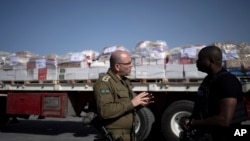With the Israel-Hamas war entering its fourth month, media are looking more closely at the ethics of whether journalists should embed with Israeli forces to enter Gaza.
Currently, the only way for journalists to enter the Gaza Strip is by embedding with the Israel Defense Forces, or IDF. But that access is restricted and risks skewing an audience’s understanding of the conflict, according to some reporters and analysts.
“It’s incredibly frustrating that we don’t have more access to Gaza,” Steve Hendrix, Jerusalem bureau chief for The Washington Post, told VOA.
“But they’re not budging. They’re not letting anybody in except in these very strict, very controlled, guided tours,” Hendrix said, referring to the IDF.
Others say that the restrictions on access risk providing an imbalanced picture to international audiences.
“They are shown what the army wants them to see, and then they leave,” Nour Odeh, a Palestinian political analyst, told VOA from Ramallah in the occupied West Bank.
Up until the Hamas terrorist attack on October 7, journalists could enter Gaza with credentials from Israel’s Government Press Office and permission from Hamas, which governs Gaza.
Israeli journalists — and nationals in general — are not permitted to enter Gaza, and neither are Palestinians who live in the occupied West Bank.
But since October 7, journalists looking to report from Gaza are able to enter only if they embed with the IDF and agree to conditions, including to not wander from the IDF tour and to submit coverage for prepublication approval by the military.
“The army has full control over who goes in, where you go and what you see,” said Josef Federman, the longtime news director for Israel, the Palestinian Territories and Jordan at The Associated Press.
At least 85 journalists killed
To date, the only exception has been CNN’s Clarissa Ward, who in December entered Gaza via Rafah without an IDF escort.
Hamas, meanwhile, has never offered embeds, reporters say, and typically blocked journalists from covering the group’s military activity.
The IDF did not reply to VOA’s email requesting comment.
But Lior Haiat, the spokesperson of Israel’s Foreign Ministry, told VOA that Hamas “is manipulating information of civilians and reporters.”
Haiat claimed that nearly half of the reporters that Hamas has said were killed by Israel “were actually terrorists.”
As of February 6, at least 85 journalists have been killed since the war began, according to investigations by the Committee to Protect Journalists, or CPJ. They are part of the overall death toll of around 26,000 people in Gaza and 1,200 in Israel.
It’s common for militaries to impose restrictions on journalists when embedding, analysts say, such as agreeing to not report on troop movements or weapons capabilities. But the IDF’s restrictions are harsher than normal, they said.
Those who are in favor of embedding told VOA that while it doesn’t allow the access they would like, they believe limited access is better than none.
“The question we have to ask ourselves is, is the freedom to report that we give up counterbalanced by the rare opportunity to get our own eyes on even part of the situation there?” Hendrix said.
Hendrix embedded with the IDF in Gaza in November and said he convinced the military to waive its prepublication censorship stipulation for him.
'Whole thing is so highly controlled'
But to Federman, getting out of that requirement is a small win, because “the whole thing is so highly controlled.”
As a journalist based in Israel for two decades, Federman still believes embedding is worth it.
“Right now, we’re in a period of very imperfect access. So, it’s better than nothing. It’s far from ideal,” said Federman, who is also a board member of the Foreign Press Association in Jerusalem.
In December, the journalist association filed a petition with Israel’s Supreme Court requesting the court to grant reporters independent access into Gaza. The court rejected the appeal in January.
Kelly McBride, chair of the Craig Newmark Center for Ethics and Leadership at the Poynter Institute, said she sees little value in embedding.
“This is more like a staged theater event than it is a genuine look at what’s going on,” McBride told VOA from St. Petersburg, Florida.
If journalists do embed, McBride said, it’s important to be upfront with audiences about what restrictions they experienced.
“You should let the audience know, ‘Hey, I’m looking through this window that the military gave me,’” she said.
Issues around embeds are not particularly new, according to Subramaniam Vincent, director of journalism and media ethics at Santa Clara University.
In the Israel-Hamas war, but also more broadly, Vincent said it’s important for journalists to recognize that militaries have their own reasons for letting journalists embed.
“They see control of the narrative as a tool,” Vincent said. “They look at the media as a strategic tool for the conflict and for power.”
It falls on reporters to make sure they don’t become a tool for the military, said Dalia Hatuqa, a freelance journalist based between Ramallah and Amman, Jordan.
She said there could be value in embedding as long as the journalist is prepared to hold the IDF accountable and ask tough questions. But too often, that coverage “takes the word of the Israeli army as gospel,” Hatuqa said.
“There’s always that fear that you could become a propaganda mouthpiece,” she said.













